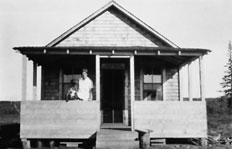Dr. Mary Evangeline Percy Jackson, 1904-2000

Dr. Mary Evangeline Percy (later Jackson) was a pioneering doctor in the Peace River district – at that time an isolated and sparsely settled area of northern Alberta. She found that the life brought rewards but also unexpected hardships.
For example, as the only doctor in the district, she delivered her own seven-week premature baby (in breech position) in -58°C weather with only her husband helping her.
On this web page, you'll find three stories about Dr. Jackson:
One of the first "provincial physicians"
Dr. Percy came to Alberta in 1929 from Britain, joining three other female physicians. The province was recruiting the first salaried (or ”provincial”) physicians, to serve settlers, Métis and First Nations living in northern Alberta. Her salary was $2,400 per year plus a medical drug allowance.
Dr. Percy was assigned to the most northerly district — Notikewan — about 112 km north of Peace River. Although she had no medical colleagues closer than Peace River and Fort Vermilion, she thrived in her new position.
Unworried by its isolation, she wrote, “I’ve got the whole valley to myself. There’s not a light to be seen. There’s something overpowering about the size of Canada.” Her cottage was 3 km from the nearest neighbour, 3 km from the end of the telegraph and two weeks between mail deliveries.
When she came to Alberta, Dr. Percy only planned to stay until an obstetrical position became available in India. But, by the fall of 1929, she had fallen in love with the Peace River country, later writing, “People here succeed or fail entirely on their own abilities, and though their life is hard, there is something clean and honest about it. I know I’m doing the right job. The women out here are so awfully glad to have a doctor.”
By year's end, she realized “I’ve gained a reputation that I might never have in a life-time in England and above all, the work is worth it.”
A busy week
In the spring of 1930, Dr. Percy described one of her busiest weeks.
Arriving home at midnight after a house call, Dr. Percy was met by a husband asking her to see his pregnant wife. After 32 km of riding through swollen rivers (and galloping the last 3 km), they found the wife without a pulse. Dr. Percy stabilized the mother (who was hemorrhaging), delivered the baby and stayed 14 hours to ensure that the mother’s bleeding stopped.
Right after Dr. Percy arrived home, another man knocked on her window at 1 a.m. asking her to see his wife. Finding that the wife had appendicitis, Dr. Percy transferred her to Peace River.
Another man soon arrived at her home also asking her to see his wife. After riding 14 km to see this patient, Dr. Percy stayed with her most of the next 24 hours. She then rode about 65 km to revisit her first patients (the mother and baby) before accompanying the patient with acute appendicitis by sleigh and Caterpillar to Peace River, where she had to stay and give the anesthetic.
In eight days, she had ridden about 286 km, survived a snowstorm and nearly drowned during one river crossing.
Marriage and motherhood in the North
Being the only doctor in the Peace River district meant that Dr. Percy Jackson had to guide her husband through the difficult delivery of their seven-week premature baby in -58°C weather.
In the fall of 1930 Dr. Mary Percy met Frank Jackson, who had lost his wife following a post-partum hemorrhage one month after their third son was born. Life became even more difficult for him when he developed a badly infected hand. As Dr. Percy was the nearest doctor, he travelled about 110 km south in -40°C weather to see her. By then he was suffering from blood poisoning. Dr. Percy lanced his hand, and he began to recover.
Engaged in 1931, they traveled to Peace River to buy the only wedding ring in town. During the trip, both developed mild cases of carbon monoxide poisoning from a hole in the car’s floorboards. They arrived back in Notikewan three hours late for their own wedding.
After several years in a remote area in Canada, the clothes she brought with her from England no longer fit: “All my really interesting clothes – beaded moccasins and gloves, leather chaps, moose hide coat, etc., are only suitable for the wilds.”
The Jacksons had two children. As she was about to leave for Grande Prairie to deliver her second baby, Dr. Jackson discovered that the baby was in a breech position, which she was unable to rotate. With only her husband helping her, she delivered a seven-week premature baby in -58°C weather. Fortunately, mother and baby survived.
Her marriage meant that Dr. Jackson would move about another 11 km north to Keg River and remain there for the rest of her life, as the only physician for about 2,600 sq. km.
Get the whole story!
|
 Read the full profile of Dr. Jackson in Dr. Robert Lampard's "Alberta's Medical History"
Read the full profile of Dr. Jackson in Dr. Robert Lampard's "Alberta's Medical History"